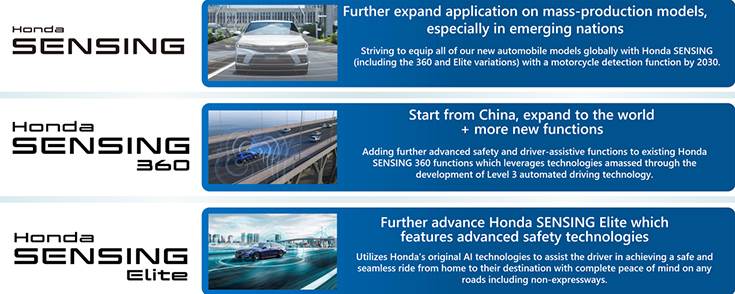On December 1, Honda Motor Co unveiled the next-generation technologies of the Honda Sensing 360 omnidirectional safety and driver-assistive system, and Honda Sensing Elite, a flagship variation.
The Honda Sensing safety and driver-assistive system which Honda currently applies to its mass-production models is installed in 99% of Honda’s new automobile models sold in Japan and the U.S. and 86% globally. Cumulative sales of vehicles equipped with Honda Sensing now tops 14 million units.
The Japanese carmaker has been continuously advancing Honda Sensing functions. In 2021, it Honda launched Sensing Elite with the Traffic Jam Pilot function, which qualifies for Level 3 automated driving technology. By leveraging know-how amassed through the research and development of Sensing Elite technology, Honda developed the Sensing 360 omnidirectional safety and driver-assistive system, which removes blind spots around the vehicle and contributes to collision avoidance and the reduction of driver burden. The application of Honda Sensing 360 will begin in 2022, starting from China.
 Sensing 360 enables new functions to reduce driver burden by detecting abnormal conditions occurring to the driver and vehicle’s surroundings to prevent collisions. These new functions will be added to the current Honda Sensing 360 and applied sequentially on a global basis starting in 2024.
Sensing 360 enables new functions to reduce driver burden by detecting abnormal conditions occurring to the driver and vehicle’s surroundings to prevent collisions. These new functions will be added to the current Honda Sensing 360 and applied sequentially on a global basis starting in 2024.
As the next generation technologies of Sensing Elite, Honda has also announced newly developed functions based on the enhanced recognition and understanding technologies achieved by the utilisation of Honda’s original AI technologies. These new functions will assist the driver in achieving a safe and seamless ride from home to their destination with complete peace of mind on any roads, now including non-expressways.
Motorcycle detection function on the cards
As for future plans, Honda is working towards equipping all of its new automobile models globally with Honda Sensing (including the 360 and Elite variations) with a motorcycle detection function by 2030. Moreover, the company states that it “will strive to equip all new models in all major markets with Honda Sensing 360 by 2030, while also continuing to advance Honda Sensing functions.” Through these initiatives, the automaker is aiming to reduce global traffic collision fatalities involving Honda motorcycles and automobiles by half by 2030.
Honda is striving for zero traffic collision fatalities involving Honda motorcycles and automobiles globally by 2050. It plans to do so by leveraging strengths unique to a company that conducts both motorcycle and automobile business in the research and development of safety technologies.
